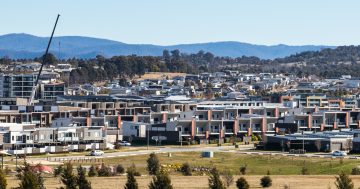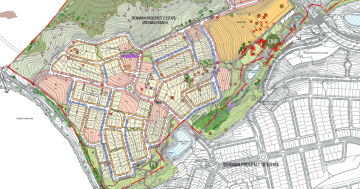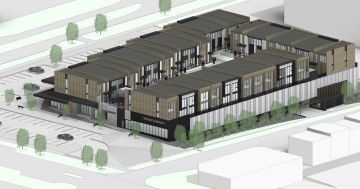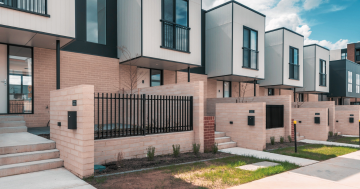
Four in a row: An artist’s impression of the Deakin proposal. Image: Cox Architecture.
Recent development applications for the redevelopment of single residential blocks in Canberra’s suburbs have again highlighted loopholes in the ACT’s broken planning system.
It seems the government’s review of the planning system can’t come soon enough with developers finding ways to do what they do best – maximising their investment – despite zonings and lease conditions.
Unfortunately, they and their representatives are very good at working within the existing rules to produce an outcome that, to most, may not look like it could pass muster but ticks all the boxes.
Resident groups fear that approvals for such projects will contribute to creeping densification across the residential zones, particularly RZ1, despite the government’s Living Infrastructure goals that aim for an average 30 per cent canopy cover and 30 per cent permeable surfaces across Canberra, and plot ratios that seek to preserve green space on blocks.
One DA in Lyons uses allowances for adaptable housing to propose three dwellings on an 896 square metre block with a plot ratio of 50 per cent instead of the 35 per cent required for normal residences.
Here it seems the proponent has used exemptions designed to support housing development for ageing in place and those with disabilities to max out the block.
Under the rules, the dwellings only need to be built ready to be adapted, not completed specifically for those with special needs.
Once sold, there is no guarantee that the residences will ever house people with a disability.
The neighbour acknowledges that the RZ2 site could take two dwellings but fears for his own trees, garden and privacy, as well parking issues on a quiet loop street with restricted parking, if this proposal goes ahead.
In a Deakin RZ1 zone, a former 867 square metre public housing site, known as a non-standard block, has been slotted for a two-storey, four townhouse development with basement parking.
Being a former public housing site, the lease does allow two dwellings. The Deakin Residents Association calls it an accident of history, but apparently, these legacy blocks are highly sought after.
The DRA, which has lodged a strong objection to the proposal, says the site also manages to escape some of the requirements of the multi-unit code, facilitating the push for four townhouses. The proponent still has to get the lease changed.
In both these instances, the objections aren’t based on opposition to infill per see, but how these sorts of proposals nibble away at the garden suburb fabric, set precedents, impact their neighbours and harden the urban landscape.
Apart from infill, they may be within the rules but not in the spirit of the government’s own planning goals.
The rules around adaptable housing should be tightened so they cannot be exploited and, in the end, frustrate their intent to have more accessible homes.
Loopholes such as the non-standard block should be closed to prevent over-development in RZ1 zones.
Draft Variation 350 to the Territory Plan was introduced in 2019 as a response to these very concerns about the suburban nature of RZ1 zones being compromised by denser development, with the support of the Planning Minister and the Chief Planner.
But it seems the proposals still come.
No one is saying there shouldn’t be any urban infill or more diverse housing, just that it should be appropriate to its location and comply with the policy goals designed to maintain the urban forest, the green cloak and keep our suburbs cool.





















